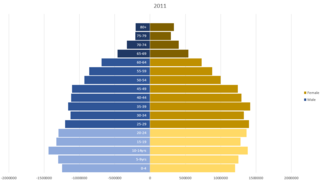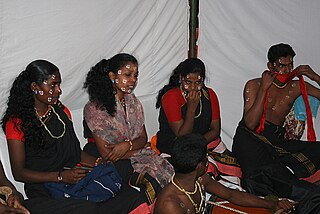
Wayanad is a district in the north-east of the Indian state of Kerala, with administrative headquarters at the municipality of Kalpetta. It is the only plateau in Kerala. The Wayanad Plateau forms a continuation of the Mysore Plateau, the southern portion of Deccan Plateau which links the Western Ghats with the Eastern Ghats. It is set high in the Western Ghats with altitudes ranging from 700 to 2,100 meters. Vellari Mala, a 2,240 m (7,349 ft) high peak situated on the trijunction of Wayanad, Malappuram, and Kozhikode districts, is the highest point in Wayanad district. The district was formed on 1 November 1980 as the 12th district in Kerala, by carving out areas from Kozhikode and Kannur districts. An area of 885.92 km2 in the district is forested. Wayanad has three municipal towns—Kalpetta, Mananthavady and Sulthan Bathery. There are many indigenous tribes in this area. The Kabini River, a tributary of Kaveri River, originates at Wayanad. Wayanad district, along with the Chaliyar valley in the neighbouring Nilambur in Malappuram district, is known for natural gold fields, which are also seen in other parts of the Nilgiri Biosphere Reserve. Chaliyar river, which is the fourth longest river of Kerala, originates on the Wayanad plateau. The historically important Edakkal Caves are located in Wayanad district.

The Adivasi are a heterogeneous tribal groups across the Indian subcontinent. The term is a Sanskrit word coined in the 1930s by political activists to give the tribal people an indigenous identity by claiming an indigenous origin. The term is also used for ethnic minorities, such as Chakmas of Bangladesh, Bhumiputara Khasas of Nepal, and Vedda of Sri Lanka. The Constitution of India does not use the word Adivasi, instead referring to Scheduled Tribes and Janjati. The government of India does not officially recognise tribes as indigenous people. The country ratified the International Labour Organization (ILO) Convention 107 on Indigenous and Tribal Peoples of the United Nations (1957) and refused to sign the ILO Convention 169. Most of these groups are included in the Scheduled Tribe category under constitutional provisions in India.

Bhil or Bheel is an ethnic group in western India. They speak the Bhil languages, a subgroup of the Western Zone of the Indo-Aryan languages. Bhils are members of a tribal group outside the fold of Hinduism and the caste system.

The Kurukh or Oraon, also spelt Uraon or Dhangad, are a Dravidian speaking ethnolinguistic group inhabiting Chhotanagpur Plateau and adjoining areas - mainly the Indian states of Jharkhand, Odisha, Chhattisgarh, and West Bengal. They predominantly speak Kurukh as their native language, which belongs to the Dravidian language family. In Maharashtra, Oraon people are also known as Dhangad.
Irula is a Dravidian language spoken by the Irulas who inhabit the area of the Nilgiri mountains, in the states of Tamil Nadu, Kerala, and Karnataka, India. It is closely related to Tamil. It is written in the Tamil script.

Irula, also known as Iruliga, are a Dravidian ethnic group inhabiting the Indian states of Tamil Nadu, Kerala and Karnataka. A scheduled tribe, their population in this region is estimated at around 200,000 people. People of Irula ethnicity are called Irular, and speak Irula, which belongs to the Dravidian languages family.

Khonds are an indigenous Adivasi tribal community in India. Traditionally hunter-gatherers, they are divided into the hill-dwelling Khonds and plain-dwelling Khonds for census purposes, but the Khonds themselves identify by their specific clans. Khonds usually hold large tracts of fertile land, but still practice hunting, gathering, and slash-and-burn agriculture in the forests as a symbol of their connection to, and as an assertion of their ownership of the forests wherein they dwell. Khonds speak the Kui language and write it in the Odia script.

Kotas, also Kothar or Kov by self-designation, are an ethnic group who are indigenous to the Nilgiri Mountains range in Tamil Nadu, India. They are one of the many tribal people indigenous to the region.. Todas and Kotas have been subject to intense anthropological, linguistic and genetic analysis since the early 19th century. Study of Todas and Kotas has also been influential in the development of the field of anthropology. Numerically Kotas have always been a small group, not exceeding 1,500 individuals spread over seven villages for the last 160 years. They have maintained a lifestyle as jacks-of-all-trades such as potters, agriculturalist, leather workers, carpenters, and blacksmiths, and as musicians for other groups. Since the British colonial period they have had greater educational opportunities. This has improved their socio-economic status and they no longer depend on providing their traditional services to make a living. Some anthropologists have considered them to be a specialised caste as opposed to a tribe or an ethnic group.

Kerala is a state in south-western India. Most of Kerala's 34.8 million people are ethnically Malayalis. Most of the Malayalam and English speaking Keralites derive their ancestry from Dravidian communities that settled in Kerala. Additional ancestries derive from millennia of trade links across the Arabian Sea, whereby people of Arab, Jewish, Syrian, Portuguese, English and other ethnicities settled in Kerala. Many of these immigrants intermarried with native Malayalam speakers resulting in formation of many Muslim and Christian groups in Kerala. Some Muslims and Christians thus take lineage from Middle Eastern and European settlers who mixed with native population.
The Paliyan, or Palaiyar or Pazhaiyarare are a group of around 9,500 formerly nomadic Dravidian tribals living in the South Western Ghats montane rain forests in South India, especially in Tamil Nadu and Kerala. They are traditional nomadic hunter-gatherers, honey hunters and foragers. Yams are their major food source. In the early part of the 20th century the Paliyans dressed scantily and lived in rock crevices and caves. Most have now transformed to traders of forest products, food cultivators and beekeepers. Some work intermittently as wage laborers, mostly on plantations. They are a Scheduled Tribe. They speak a Dravidian language, Paliyan, closely related to Tamil.
The indigenous people of Bangladesh are ethnic minorities in Chittagong Hill Tracts (southeastern), Sylhet Division (northeastern), Rajshahi Division (west), and Mymensingh Division (north-central) areas of the country. They are indigenous and the tribal races, total population of ethnic minorities in Bangladesh was estimated to be over 2 million in 2010. They are diverse ethnic communities including Tibeto-Burman, Austric and Dravidian people.
The Malto or Maler people, also known as Pahariya, are a Dravidian tribal group from the Rajmahal Hills in the northeastern Chota Nagpur Plateau. They are divided into three subgroups: Mal Paharia, Sauria Paharia and Kumarbhag Paharia. All three are listed as Scheduled Tribes in Jharkhand, Bihar and West Bengal. They speak Malto, related to the nearby Kurukh language.

The population of Kerala, India is a heterogenous group that comprises many ethnic groups that originated in other parts of India as well as the world, with distinctive cultural and religious traditions. While the majority of Keralites speak the Malayalam language, various ethnic groups may speak other languages as well.
Kattunayakar or Jennu Kurumbas an indigenous community, is a designated scheduled tribe in the Indian states of Tamil Nadu, Karnataka, Kerala, and Andhra Pradesh. The word Kattunayakar காட்டு நாயகர் / ಕಾಡು ನಾಯಕರು means the king of the jungle in Tamil and Kannada. The Kattunayakar are one of the earliest known inhabitants of the Western Ghats, who are engaged in the collection and gathering of forest produce, mainly wild honey and wax.

Kakkadampoyil, is a small village in Kozhikode district, Kerala, India bordered with Malappuram district. The village has recently emerged as a major tourist destination in the district.
Tamil Nadu is one of the 28 states of India. Its capital and largest city is Chennai. Tamil Nadu lies in the southernmost part of the Indian Peninsula and is bordered by the States of Puducherry, Kerala, Karnataka and Andhra Pradesh. It is the tenth-largest state in India and the seventh most populous state.
Languages spoken in the Indian Subcontinent belong to several language families, the major ones being the Indo-Aryan languages spoken by 75% of Indians and the Dravidian languages spoken by 20% of Indians. Other languages belong to the Austroasiatic, Sino-Tibetan, Tai-Kadai, and a few other minor language families and isolates. India has the world's second-highest number of languages (780), after Papua New Guinea (839). The first known translation of any Christian Scripture in an Indian language was done to Konknni in 1667 AD by Ignazio Arcamone, an Italian Jesuit.

The Paniya, also known as Paniyar and Paniyan, are an ethnic group of India. They constitute the single largest Scheduled Tribe in Kerala and are mainly found in the Wayanad District and the neighbouring areas of Karnataka. They primarily inhabit villages around edge of forestland in Kerala's Wayanad, Kozhikode, Kannur and Malappuram districts. The Paniya speak the Paniya language, which belongs to the Dravidian family, closely related to Malayalam. The center of the bonding contracts was the famous temple of the regional mother goddess of the Valliyoorkkavu shrine near Mananthavady.

The Mavilan are a Scheduled Tribe of the Indian state Kerala. They inhabit the hill country of the Kannur and Kasaragod districts. They speak Tulu as their primary language and also have knowledge of Malayalam.
Cholanaikkan is Southern Dravidian language spoken by the Cholanaikkan people in the hilly forests of the Nilambur Valley of Malappuram district of Kerala. They are largely a primitive hill tribe living in rock shelters near rivers in the valley. Some linguists consider the language to be distinct and that considering it an admixture of Tamil, Malayalam and Kannada as erroneous.











